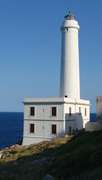Capo d'Otranto
Coordinates: 40°06′26″N 18°31′14″E / 40.10722°N 18.52056°E
 Punta Palascia Lighthouse | |
 Apulia | |
| Location |
Otranto Apulia Italy |
|---|---|
| Coordinates | 40°06′26.72″N 18°31′11.56″E / 40.1074222°N 18.5198778°E |
| Year first constructed | 1867 |
| Deactivated | 1970s - 2009 |
| Construction | stone tower |
| Tower shape | cylindrical tower with balcony and lantern atop a 2-storey keeper’s house |
| Markings / pattern | white tower, grey lantern dome |
| Height | 32 metres (105 ft) |
| Focal height | 60 metres (200 ft) |
| Current lens | type TD |
| Light source | mains power |
| Range |
main: 18 nautical miles (33 km; 21 mi) reserve: 12 nautical miles (22 km; 14 mi) |
| Characteristic | Fl W 5s. |
| Admiralty number | E2178 |
| NGA number | 10788 |
| ARLHS number | ITA-137 |
| Italy number | 3596 E.F. |
| Managing agent | City of Otranto[1][2] |
Cape Palascìa, commonly known as Capo d'Otranto, is Italy's most easterly point. It is situated in the territory of the Apulian city of Otranto, in the Province of Lecce at 40° 7' northing and 18° 31' easting.
Lighthouse
The lighthouse there was built in 1867 and abandoned in the 1970s but and reopened to tourists in 2008, where it hosts the Centre on Environment and Health of the Mediterranean ecosystems and a multimedia museum of the sea. It is one of five Mediterranean lighthouses protected by the European Commission. It is often visited by tourists, especially at New Year, since it stands at the point where the dawn of the new year may first be seen in Italy.
According to nautical conventions, Capo d'Otranto marks the point where the Ionian Sea and the Adriatic Sea meet.
See also
References
- ↑ Capo d'Otranto (La Palascia) The Lighthouse Directory. University of North Carolina at Chapel Hill. Retrieved 5 August 2016
- ↑ Capo d’Otranto Faro di Punta Palascia Marina Militare. Retrieved 5 August 2016
External links
| Wikimedia Commons has media related to Capo d'Otranto. |